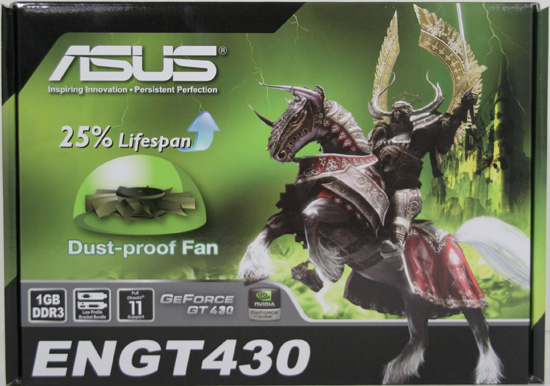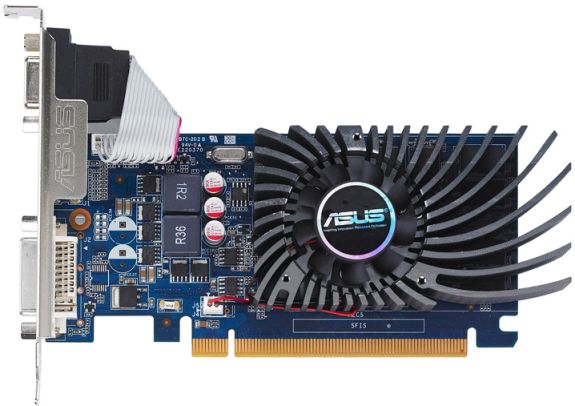NVIDIA's GeForce GT 430: The Next HTPC King?
by Ryan Smith & Ganesh T S on October 11, 2010 9:00 AM ESTMeet the Asus ENGT430
For our look today at the GT 430, Asus graciously provided us with their GT 430 card, the ENGT430. As with all the other cards being released it’s a custom design, featuring the usual Asus design elements: a double-sealed fan, fuse protection, and - while we have a hard time believing this is an issue on such a small card – GPU guard PCB reinforcement.
For this card Asus is very specifically going after the HTPC market. The ENGT430 is a half-height card with a low-profile bracket included, and for cooling it uses a decently sized heatsink with a particularly tiny fan we measure at 36mm. The heatsink does stick up some, so the card is explicitly a double-slot card and you’ll want to make sure you have space for it.
As is the case with low-end cards, reference clocks don’t tend to mean much. While the GT 430 has a reference speed of 700MHz for the core and 1.8GHz effective for the DDR3 memory, Asus has gone ahead and clocked the card at 1.6GHz for the memory. The card is equipped with 8 800MHz (1.6GHz effective) Hynix DDR3 memory modules running in 16bit mode, which is why the card is clocked below NVIDIA’s reference clocks. We expect to see memory clocks all over the place with the launch cards, depending particularly on who could get the best deal on what speed grade of DDR3 RAM for these cards. Given that GT 430 is likely already a memory bandwidth challenged card, this will have an impact, although we don’t have the means to measure it (our card would only go to 1.75GHz on the RAM).

For ports Asus is going with what’s undoubtedly going to be the universal configuration for low-profile GT430 cards: 1x DVI, 1x HDMI, and 1 VGA port. The DVI port is necessary for monitors (without resorting to a dongle), the HDMI port is necessary for HTPC roles, and the VGA port being an easy addition as an optional 3rd port due to its analog nature. GF108 can only drive 2 monitors at once, so the usual restrictions apply.
As is common for budget cards, there’s little else besides the card in the box. Asus includes the low-profile bracket, a multilingual quick installation guide, and a driver CD. This is the first Asus card we’ve reviewed for some time without voltage tweaking capabilities, so even NVIDIA’s integrated overclocking utility is enough for the task.












120 Comments
View All Comments
esc923 - Monday, October 11, 2010 - link
Well you answered which means you do care, which is why I fully agree when you say that you could care less how smart anyone thinks you are.I'm not going to bother with reasoning out your obsession with video game FPS as the main 'objective' measure of an HTPC card while dismissing all else, as it's lost on you. Instead, let's try it the man no way instead: your argument is not correct because I say so.
manno - Tuesday, October 12, 2010 - link
Don't take this the wrong way, but just because someone responds to a forum post does not mean they care what anybody thinks of them.From the article:
"Whether it’s by NVIDIA’s design or matters out of their hands, GT 430 simply isn’t competitive with AMD’s 5570 and 5670 in gaming performance, with the latter cleaning the GT 430’s clock every single time. NVIDIA isn’t pushing the GT 430 as a gaming performance card so we aren’t going to recommend it as one. If you need budget gaming, then the only choice to make is to go AMD."
again for all intents and purposes the 430 and the 5570 are the same card. Same performance same price-point one is not superior to the other. Of course the 5670 is better, it's aimed at a different segment. My issue with the article isn't with you it's with "Ryan Smith & Ganesh T S" who draw the wrong conclusion. From the article:
"We always hate to rely so much on a single benchmark, but at this point HQV 2 provides the best tests we can get our hands on."
This is wrong to test image quality the best test they could use is a subjective one ie: a double blind test where they play the same clip on the two different platforms to random test subjects. Using AMD's IQ benchmarks to judge any card is inherently biased I don't care what AMD says. Just like using Nvidia's CUDA benchmarks.
The article's conclusion regarding the 430 vs 5770 is wrong for the time being do a double-blind test and revisit it. Regarding then430 vs 5770 in gaming performance conclusion, well that's just plain wrong.
ganeshts - Tuesday, October 12, 2010 - link
I am not sure where you got the idea that HQV is an AMD benchmark.HQV is an independent company and has their own video processing chip. They are not related in any way to AMD or nVidia.
manno - Tuesday, October 12, 2010 - link
My mistake and thank you for the correction.geok1ng - Tuesday, October 12, 2010 - link
well manno, that is the trollest behavior i have ever witnessed on the subject of $79 video cards.assuming you are NOT a troll, then TomsHardware and HardOCP are also wrong in the comparison with the 5570. Hardly.
Since AMDs 785G there is no need for a VGA in order to play blurays , except for 2 situations:
The very few that own a high end sound system ( $1500+) and swear that they can hear the "gap" in quality when going from 7.1 bitstreaming to lossless HD audio. These buyers do NOT pick a $79 VGA, they build a custom PC-based digital audio system to work with theirs bitperfect setup. If you dont know what bitperfect is, then dont bother trolling that the 430 is better than the 5570.
The not so very few that own a 3D TV: in 3D playback since it is lost half the resolution and/or half the brigthness image quality becomes even more important. After spending 3k+ on the TV i fail to see the reasoning on choosing the 430 over the 450, or the 460, that at least can game.
I say that HTPCs cards are a thing of the past since the 785G, HD audio is a much hyped and rarely used feature and 3D Bluray is a niche.
And the fair competitor for the 430 in 3D Bluray comes from the PS3, hence the need to compare this card image quality with the PS3, with camera pictures to silence the trolls.
8steve8 - Monday, October 11, 2010 - link
the next htpc king is sandy bridge graphics.i mean even westmere is good enough for most.
Lolimaster - Monday, October 11, 2010 - link
You mean Fusion Llano?SB is on par with the low end IGP Fusion Ontario.
8steve8 - Monday, October 11, 2010 - link
no i didn't mean llano, but any integrated graphics solution in 2011 will be fine for most people's HTPC needshmcindie - Monday, October 11, 2010 - link
I don't get the point of HQV? PowerDVD and WinDVD do all the processing themselves so the drivers shouldn't have anything to do with it.HQV also has a couple of completely ridiculous tests and hasn't been used seriously to gauge image quality in DVD's for a long while now.
hmcindie - Monday, October 11, 2010 - link
And why don't you guys tell what software you were even using? Wtf?